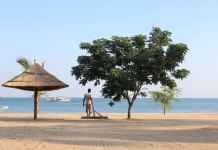
The Kwame Nkrumah Memorial Park in Accra has been closed temporarily to allow managers to undertake maintenance and upgrade works on the facility.
The Park was closed on Friday, May 27, a statement issued by the Ministry of Tourism said.
“It is announced for the information of the general public that there will be a temporary closure of the Kwame Nkrumah Memorial Park with effect from today Friday, May 27 2022 until further notice.
“This is to allow for major works to upgrade the memorial park to a standard that befits the stature of the former president and boost the attractiveness of the park and the overall tourism performance of the country,” the statement said.

The mausoleum, designed by Don Arthur, houses the bodies of Kwame Nkrumah and his wife Fathia Nkrumah.
The Kwame Nkrumah Mausoleum is the final resting place of Nkrumah and his wife, Fathia, an Egyptian woman. The mausoleum was built where Nkrumah chose to announce Ghana’s independence. The reason why he chose that area was because that was where the British used to play polo.
Located in downtown Accra, Ghana is the Kwame Nkrumah Memorial Park and Mausoleum. The Mausoleum is the final resting place of Ghana’s first President and Africanist. The museum hosts rare artefacts relating to Ghana’s independence and tours at the park give visitors in-depth history of the Sub-saharan struggle for independence.
The mausoleum designed by Don Arthur houses the mortal remains of Dr. Kwame Nkrumah and his wife Fathia Nkrumah. It is meant to represent an upside-down sword which in the Akan culture is a symbol of peace. The mausoleum is clad from top to bottom with Italian marble, with a black star at its apex to symbolize unity. The interior of the Mausoleum boasts marble flooring and a mini mastaba looking marble grave marker surrounded by river-washed rocks.
A skylight at the top in the Mausoleum illuminates the grave, and at the right time, seems to reflect off the marble further emphasizing that beauty many have come to fall in love with.
The Mausoleum is surrounded by water which is a symbol of life. Its presence conveys a sense of immortality for the name Nkrumah. It shows that even in death he lives on in the hearts and minds of generations here and generations yet to come.
The entrance to the site is from the 28th February High Street just along the coast from Independence Square. It is located directly opposite the old Paliarment House now known as the Commission for Human Rights and Administrative Justice(CHRAJ).
It has a total surface area of approximately 5.3 acres. The mausoleum provides a front for the statue of Nkrumah whereas the museum is subterranean and does not compete with the mausoleum for attention. Rhythm, contrast and harmony were the main principles of design used in this building.


















